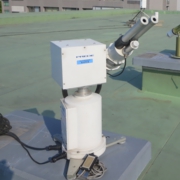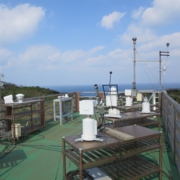SKY RADIOMETER
POM-01, -02 series: PREDE CO., LTD., Tokyo, Japan
Aerosols and cloud play an important role in the Earth climate change. We started the long-term monitoring of aerosol and cloud optical properties since 1990’s by using sky radiometer (Prede Co., Ltd., Tokyo, Japan). The sky radiometer is an automatic instrument that takes observations only in daytime. Observation of direc and diffuse solar intensity interval was made every ten minutes by once. The aerosol optical properties were computed using the SKYRAD.pack version 4.2 (Nakajima et al., 1996). The obtained Aerosol optical properties (Aerosol optical thickness, Ångström exponent, Single scattering albedo, and etc.) and size distribution volume clearly showed spatial and temporal variability.

SKYNET
Atmospheric Radiation Observation Network
SKYNET Project is a grass roots effort to make a network to measure the atmospheric radiation and related atmospheric parameters to help the analysis. BSRN and GAW are the international networks useful for SKYNET to learn how to select and set the instruments for radiative flux measurements. NASA AERONET is another network for SKYNET to be coordinated for performing sun/sky brightness measurements. SKYNET instrumentation has been designed to be effective for comprehensive understanding the transfer process of the atmospheric radiation. Therefore, the minimal instrumentation should be sun/sky photometer (hereafter we call such instrument as skyradiometer) and uplooking shortwave radiative flux meter (hereafter pyranometer) to study downward showtwave flux in the clear sky condition. More comprehensive instrumentation should be downlooking pyranometer and up/down looking longwave radaitive flux meter (hereafter pyrgeometer, though this definition is not exactly correct), and lidar. Dual frequency microwave radiometer and Skyview camera are useful for characterizing the cloud condition. Aerosol sampling is desirable for investigating the relationship between the clear sky flux and aerosol loading and properties. A routine sonde measurement site should be close to the SKYNET site for obtaining meteorological element profiles. To clear the cost issue, SKYNET has two categories depending on the degree of instrumentation, i.e. super sites and basic sites. The super sites should be fully implemented with instruments useful for the SKYNET objectives. The basic sites should have the minimal instruments, i.e., skyradiometer and pyranometer. Each site should have a site scientist who controls the instrument condition and data logging. The data are transferred to the SKYNET data center at the NIES and are processed for retrieving high level products, such as calibrated radiative flux, aerosol optical thickness and size distribution. To protect the right of the involved scientists to maintain the sites by the grass roots effort, but to maximize the benefit of the research community from SKYNET activity, SKYNET solicits users and site scientists to accept the SKYNET data policy under which the retrieved data sets are utilized for non-profitable research activities. Anyone can join SKYNET if they accept the objectives, instrumentation method, and the data policy.


 CAUTION: Data presented in the initial result data is unscreened and may not have final calibration reprocessing.
CAUTION: Data presented in the initial result data is unscreened and may not have final calibration reprocessing. NOTICE: If you have any questions and/or comments about this web page, please contact Kazuma AOKI.
NOTICE: If you have any questions and/or comments about this web page, please contact Kazuma AOKI.